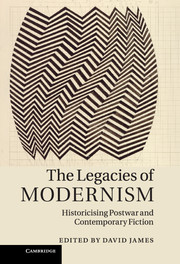Book contents
- Frontmatter
- Contents
- Notes on contributors
- Acknowledgements
- Introduction: mapping modernist continuities
- Part I Early legacies: inheriting modernism at mid century and beyond
- Part II Modernist aesthetics in transition: character, perception, innovation
- Chapter 4 Thinking in literature: modernism and contemporary neuroscience
- Chapter 5 Autonomous automata: opacity and the fugitive character in the modernist novel and after
- Chapter 6 Pseudo-impressionism?
- Chapter 7 ‘Advancing along the inherited path’: Milan Kundera, Philip Roth and the idea of being traditionally new
- Part III Reassessing the ethics of modernist fiction
- Part IV Modernism's global afterlives
- Epilogue Finding the dreadfully real
- Index
- References
Chapter 6 - Pseudo-impressionism?
from Part II - Modernist aesthetics in transition: character, perception, innovation
Published online by Cambridge University Press: 05 November 2011
- Frontmatter
- Contents
- Notes on contributors
- Acknowledgements
- Introduction: mapping modernist continuities
- Part I Early legacies: inheriting modernism at mid century and beyond
- Part II Modernist aesthetics in transition: character, perception, innovation
- Chapter 4 Thinking in literature: modernism and contemporary neuroscience
- Chapter 5 Autonomous automata: opacity and the fugitive character in the modernist novel and after
- Chapter 6 Pseudo-impressionism?
- Chapter 7 ‘Advancing along the inherited path’: Milan Kundera, Philip Roth and the idea of being traditionally new
- Part III Reassessing the ethics of modernist fiction
- Part IV Modernism's global afterlives
- Epilogue Finding the dreadfully real
- Index
- References
Summary
I
Was Henry James gay? Probably – and according to Sheldon Novick's recent biography, even somewhat actively. Records cannot prove that James had sex of any kind, but Novick's James had some sort of sex with men, including no less than Oliver Wendell Holmes. It makes a difference. The sexless Henry James can really interest contemporary readers only up to a point. The sexual James, especially one whose artiness was just sublimated sexual tension, would seem to speak to us more directly. The difference here is central to Colm Tóibín's recent novel about James, The Master (2004). Inspired in part by Novick's biography, Tóibín imagines the missing particulars of James's night in bed with Holmes and connects James's private homosexuality to his public literary persona. The result ought to have been exciting. Here, finally, would be our Henry James, and maybe even a new gay hero.
But consider one representative scene. Early in the novel, James visits the Wolseleys in Dublin Castle. Lady Wolseley knows that James likes men, so she assigns him a handsome manservant named Hammond. Late one evening, Hammond effectively offers James sex. James opts for tea instead. Afterwards, lying in bed, he thinks about what he has missed. But rather than something sexual, we get this:
He put his hands behind his head in the darkness of the bedroom, the firelight having fully dimmed. He was disturbed by the idea that he longed, now more than ever before, in this strange house in the country, for someone to hold him, not speak or move even, but to embrace him, stay with him. He needed that now, and making himself say it brought the need closer, made it more urgent and more impossible.
- Type
- Chapter
- Information
- The Legacies of ModernismHistoricising Postwar and Contemporary Fiction, pp. 114 - 132Publisher: Cambridge University PressPrint publication year: 2011
References
- 2
- Cited by



